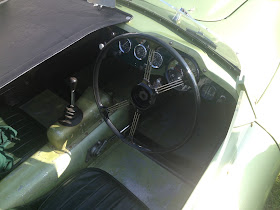Each September, British car enthusiasts convene an all-British car show in Arvada, Colorado, roughly midway between Denver and Boulder. As you'd expect, a lot of green cars show up, and some of them are pretty rare. Past examples have included vintage machines from Alvis, Bentley, Frazer Nash and HRG. This year, one of 75 Aston Martin DB-4 GT coupes showed up, a refugee from the Swinging London of the 1960s. But there was an even rarer car on the lawn at Oak Park, and that was this MG EX 186...
During the late 50s, when MG director John Thornley and design engineer Syd Enever were preparing the troubled launch of the twin-cam version of their MGA and also designing the MGB as its replacement, they also managed to produce a racing prototype aimed at an overall Le Mans win. This seemed possible because of the 2.5 liter limit imposed on pure racers (as opposed to slower production cars) after the catastrophic accident during the 1955 running of the 24-hour race. This goal appeared a tall order to some because even MG's new twin-cam engine gave away a liter of size to the bigger cars, but the design team was banking on light weight and a low, aerodynamic profile to bring victory within reach. Design included a modified MGA chassis with De Dion rear suspension*, 4-wheel disc brakes, and a light, low-drag body of aluminum alloy. On the latter, MG's metalworkers went through expensive, and almost comical, contortions to use stock lighting units, forming complex creases into the car's shell...
This near-obsessive attention to detail might have been better spent on the new 1.5 liter twin-cam engine, which upon release in the new-for-1958 Twin Cam MGA road car, soon acquired a reputation for melting pistons, fracturing tappets, and consuming large quantities of oil. The aluminum head with polished cam covers was a pretty thing to behold, though, and during the Twin-Cam's brief production run, MG and its British Motor Company parent managed to track down most of the mechanical gremlins. Not soon enough, however, to repair the damage to the new engine's reputation...
Fortunately, the little car's fate never came to that. Instead, MG employees contrived to get the racer sent in a box labeled as car parts to the San Francisco BMC distributorship run by Kjell Qvale, famed for racing MGs on the West Coast. He stored car for half a dozen years, and then sold it to enthusiasts who licensed it for road use. In 1982 the car's Colorado owners* found it and began a painstaking, long-term restoration project (restoring a car can take awhile when many of its parts are completely unique). They now have a completely functional car for warm sunny days on winding mountain roads, and for wowing visitors to car shows. And they'll never meet themselves coming down the road...
This near-obsessive attention to detail might have been better spent on the new 1.5 liter twin-cam engine, which upon release in the new-for-1958 Twin Cam MGA road car, soon acquired a reputation for melting pistons, fracturing tappets, and consuming large quantities of oil. The aluminum head with polished cam covers was a pretty thing to behold, though, and during the Twin-Cam's brief production run, MG and its British Motor Company parent managed to track down most of the mechanical gremlins. Not soon enough, however, to repair the damage to the new engine's reputation...
EX 186 was aimed at competing at Le Mans for 1959, but had been conceived and built without approval by MG's parent BMC. By the time BMC's racing-averse management found out about it, the problems with the new twin-cam engine were so well-known that production was discontinued after 1960, with only 39 of the 1,788 MGA Twin-Cams listed from that last model year. BMC's top brass, having axed the troublesome Twin-Cam, next decreed that the brand new EX 186 needed the services of the crusher...
Fortunately, the little car's fate never came to that. Instead, MG employees contrived to get the racer sent in a box labeled as car parts to the San Francisco BMC distributorship run by Kjell Qvale, famed for racing MGs on the West Coast. He stored car for half a dozen years, and then sold it to enthusiasts who licensed it for road use. In 1982 the car's Colorado owners* found it and began a painstaking, long-term restoration project (restoring a car can take awhile when many of its parts are completely unique). They now have a completely functional car for warm sunny days on winding mountain roads, and for wowing visitors to car shows. And they'll never meet themselves coming down the road...
*Footnotes: For the story of another prototype car saved from the crusher, see our post "The Italian Jobs Part 4: Saved from the Crusher" from March 13, 2016, which tells the saga of an Italian-bodied, rotary-powered Corvette... Along with EX 186, MG also designed a new lightweight tubular chassis to fit under a standard-appearing MGA shell. This car was named EX 183, and we're not sure where it is. EX 186, however, has been lovingly restored over several years by owners Joe and Cathy Gunderson of Littleton, Colorado, and we want to thank them both for sharing information on this (literally) unique car.
Photo Credits: All photos by the author.




No comments:
Post a Comment